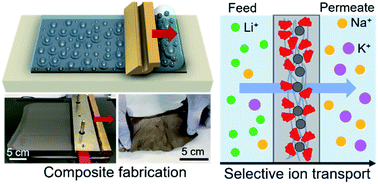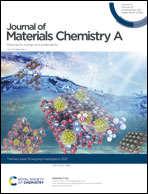Post-transition metal/polymer composites for the separation and sensing of alkali metal ions†
Abstract
The separation and sensing of alkali metal ions from aqueous lithium resources is of great importance for building future renewable and lithium-based energy storage technologies. As such, interest arises for the development of functional composites selective to ionic lithium (Li+) over sodium (Na+) and potassium (K+) that allows for a range of low carbon-footprint sensing and recovery processes. Here, selective separation of Li+ from aqueous mixtures of Na+ and K+ ions using polyvinyl alcohol/maleic acid composites was enhanced by the inclusion as nano-additives of post-transition metals gallium (Ga) and indium (In), together with their alloys and oxidized species, in the composite casting process. The co-addition of Ga and In resulted in the spontaneous formation of Ga oxides and hydroxides while In remained in the metallic state. This Ga–In composite was stable in aqueous solutions containing a high concentration (0.1 M) of mixed alkali metal ions over 5 days and achieved exceptionally high selectivities of Li+ over Na+ (3.8 ± 0.1) and K+ (7.1 ± 0.1). Results from an electrochemical sensing platform technique revealed that Li+ selectivity was in the same order as the diffusion rates. This work demonstrated that the low-melting-point post-transition metal alloy enables a one-step low energy fabrication of selective polymeric composites with diverse applications for energy, sensing and separation industries. The work has implications for the efficient manufacture of renewable and lithium-based energy storage technologies.

- This article is part of the themed collection: Journal of Materials Chemistry A Emerging Investigators


 Please wait while we load your content...
Please wait while we load your content...